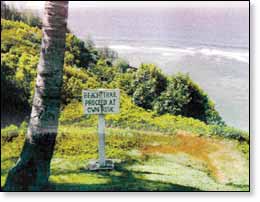For 30 years, Kaua’i fishermen and owners at the Sealodge Condominium complex at the Princeville Resort and their guests freely used a trail that led to Kaweonui Beach. Walkers were treated to bird habit, a tropical forest and a stream
For 30 years, Kaua’i fishermen and owners at the Sealodge Condominium complex at the Princeville Resort and their guests freely used a trail that led to Kaweonui Beach.
Walkers were treated to bird habit, a tropical forest and a stream that leads to the beach. The trail meanders within the border of the 20 acres located next to the 86-unit condo project, which is located on an ocean bluff.
Now Tradewinds Southwest Inc., the new owner of the property, wants to restrict access to the 20 acres, mostly hilly and remote, for liability reasons, limiting its use only to condominium owners.
Sealodge representatives have objected, saying the trail should remain open to all because it has been used by the public for 30 years.
“We want to keep that access open. Previous owners didn’t make a fuss about people using the trail,” said John Winnes, a Sealodge board member.
The board of directors of Sealodge has asked Kaua’i County officials to intercede, stressing Tradewinds’ plans mark another attempt by wealthy beachfront owners to close beach access to the public.
The subject of preserving beach access has dominated Kaua’i County Council meetings this year.
Richard Davidson, president of the Sealodge board of directors, said taking away the beach access will hurt tourism. Many tourists come to Kaua’i because they have ready access to beaches.
“If you lose these beaches and this beach as well, I don’t know what you will have over there,” Davidson said.
Davidson said the public has “prescriptive rights” for continual use of the beach and that the trail and beach are advertised in tourist publication and on the Internet.
Lihu’e attorney Patrick Childs, representing Tradewinds, said no “prescriptive easement” exists for the trail.
In spite of the placement of a safety sign on the beach, “there is no public path or private easement through this parcel,” Childs wrote in a letter to Davidson.
The path is slippery and dangerous, Childs wrote, adding, “directing people to use this path is probably foolhardy and may create liability issues in the event of a fall.”
Davidson said he is not aware of any injuries on the trail and that four safety signs and steps were installed to reduce the risks of injuries.
Childs said the new owner “wants to discourage, not encourage, the public from trespassing onto this property,” and is considering installing a fence around the property.
The prohibition would apply only to guests of condominium unit owners at this time, Childs said. The issue of allowing condominium owners, most of whom are part-time residents, to continue to use the trail has not been addressed yet, Childs said.
The prohibition would hurt local fishermen, said an employee at Sealodge.
“Local people have been using the trail for years. They dive at night and go there during the day,” said the employee, who asked not be named. “They will suffer if this goes through.”
People bought the condominium units because they were told the 20 acres would be used as a park, indicating development of the property was not likely, Sealodge representatives said.
A major development plan for Princeville Corp. identified the property as a “greenbelt,” Davidson said.
Princeville Corp. proposed to transfer the property to the Princeville Community Association at no cost and with restrictions against development, Davidson said. But the company eventually sold it to one of its employees for $10,960, Davidson said.
The property has been sold to Tradewinds for more than $1 million, Davidson said.
Staff writer Lester Chang can be reached at 245-3681 (ext. 225) and mailto:mailto:lchang@pulitzer.net


